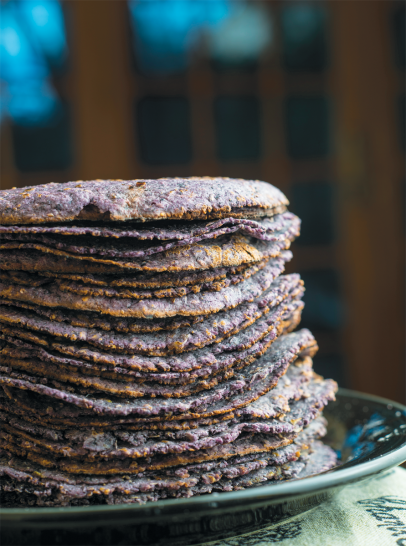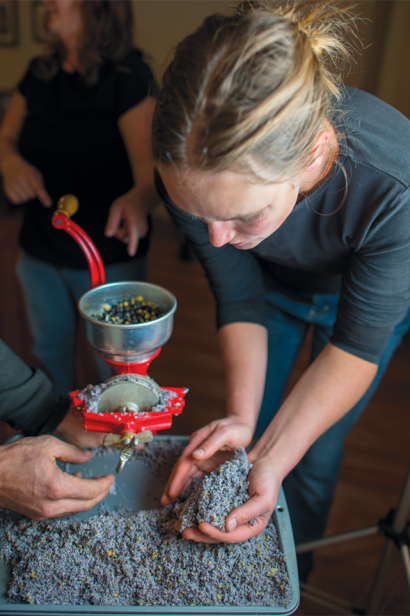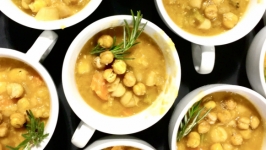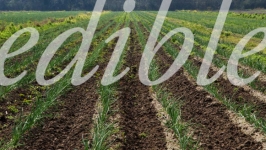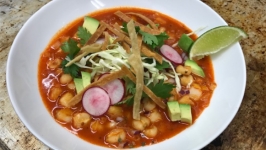Making Masa
Nowadays, corn is practically synonymous with massive, industrial monocultures of uniform, proprietary genetically modified plants that march to the horizon in ramrod-straight rows, destroying topsoil, watersheds, rural communities, wildlife habitat and human health in the chain from farm to feedlot to high-fructose corn syrup. But this is only one of the stories of corn, and it’s a relatively new and likely short-lived one at that. Moreover, it’s completely unromantic, relegating the majority of Americans to the unsatisfying role of overfed and undernourished consumers.
So let us not dwell in that agricultural war zone longer, and instead look to a story that leads to a different, more delicious outcome:
Long, long ago—say 10,000 years ago—a wild grass named Teosinte lived a simple life in the Baslas region of southern Mexico. We’ll never know whether it had an inkling of the enormous impact it was to have on human civilization. Teosinte bears little resemblance to modern corn, with small, rock-hard, angular kernels and no central cob to hold them.
Enter human beings, and the plot thickens. By passing the work and wisdom of observation and selection through countless generations, patient and diligent people in Mesoamerica partnered with the grass, transforming it over thousands of years into a crop that was larger, easier to cultivate and harvest and provided more and more delicious food. Olmec and Maya people shared their remarkable maize with other groups who adapted the corn to grow all along the spine of the Americas. Thousands of unique strains or varieties have co-evolved with their human stewards in ways that have nourished families, communities and nations physically and spiritually for millennia.
Then Aztec culture added to the story: How many Aztec culinary innovators did it take to invent and perfect the tlaxcalli (named tortilla by the Spanish conquistadores)? Was it one woman? One family? One village? For centuries, women have nourished families with this incredibly practical and nutritious food, made fresh daily and eaten with most meals. Tlaxcalnamacacas / tortilleros (folks who make tortillas) have introduced the exquisite homemade tortilla to folks like me here in Idaho who had no cultural connection to their story.
In my travels in Latin America I fell in love with homemade tortillas, and through the Rocky Mountain Seed Alliance and time in the American Southwest I have fallen in love with the corns used to make them. Now, each season I sow the seeds of at least one flour corn on my farm so that I can have some small part in what has become for me one of the most sacred and nourishing things in my life. The ritual of sowing, caretaking, harvesting and drying the corn, and then shelling, grinding, nixtamalizing and pressing it into tortillas has brought me an almost incomprehensible amount of joy and satisfaction.
In our modern world, agriculture is, as anything else, driven by demand. We have talented farmers who can grow whatever is wanted, but as of yet there hasn’t been a demand for locally grown corns for making masa for tortillas. Instead, almost every bit of the thousands of acres of corn growing in Southern Idaho is being used as silage for livestock, with a small amount of sweet corn grown for our summer BBQs.
Our current tortilla landscape in Southwestern Idaho includes large-scale, factory produced tortillas, pre-made dried masa in Mexican grocery stores, a very small handful of Mexican restaurants and/or taquerias that actually make tortillas in-house from the store-bought dried masa, and innumerable women in homes scattered across the valley making tortillas for their families—perhaps even from maize they’re growing themselves. To my (very limited) knowledge, there hasn’t yet been a more public connection between the corn used to make the masa, the masa itself and the tortilleros who make their tortillas from scratch—until now.
As local-food advocate and restaurateur Dave Krick, owner of Bittercreek/Red Feather restaurants in downtown Boise, purchased the former Pollo Rey restaurant, he has set out in his signature way to create a taco shop centered around locally grown seasonal food. And of course, the place to start is with the tortillas. Which is to say, the corn.
In a modern tale where a restaurateur can be a protagonist, there are many other satisfying roles to play. For starters, every seed needs a steward. This project is exciting because it utilizes farmers of many scales, from one-acre urban farmers to mid-sized vegetable producers to larger-scale grain farmers with combines and processing equipment.
To begin, we selected and field-trialed 24 varieties of flour and dent corns, sourced from all over the world but with a particular focus on ones we think will thrive in Idaho. Through a partnership between farmers, plant breeders and chefs, we’re identifying several promising varieties that will provide a diversity of colors, textures and tastes for several superb masas, as well as a diversity in the field which is crucial for a healthy agricultural system. When we rely on one variety of a crop to feed us, we are more vulnerable to the specific vagaries of weather, insects, disease and other factors that could take down that variety. But with a quilt of different varieties in our fields, we increase resilience. Every variety may not produce well every year, but some of them will, so there will always be food.
This winter, as Dave Krick and crew transform Pollo Rey into the more innovative, locally sourced Diablo and Sons, Chef Antonio Ortega will be experimenting with making masa and tortillas with the varieties we identify as growing well in our area, and selecting his favorite ones. Then next spring, we commence scaling them up. Through our Snake River Seed Cooperative network, we have micro farmers who are able to grow out these obscure varieties of corn, many of which are only available in one-pound packages, and grow that one pound out to 20 pounds. The next season, we can give that 20 pounds to a mid-scale farmer who can plant out three or four acres with it, which will result in enough seed for the next rung of farmer to grow out hundreds of acres of it. And voila! A new variety of corn finds its way into the diverse diet of Idahoans through the collaborative efforts of farmers, breeders and chefs.
And here we re-enter the story as eaters of a different stripe. We can play a valuable role in supporting our region’s agricultural diversity, the livelihood of small and mid-sized farmers—all while creating delicious, home-grown tortillas.


